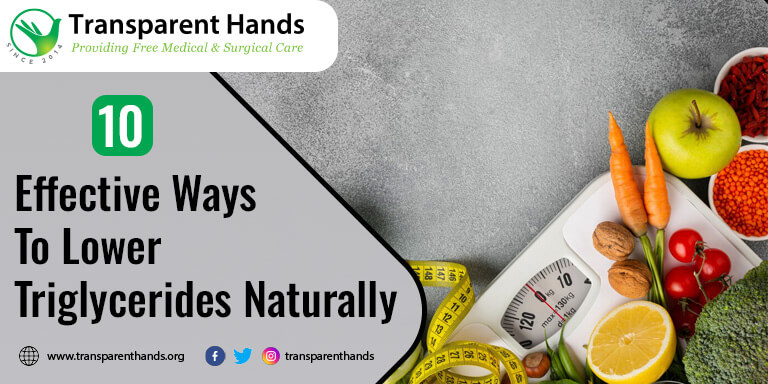10 Effective Ways to Lower Triglycerides Naturally

Triglycerides, a type of fat found in the blood, serve as the body’s primary energy source. They are derived from dietary fats and excess calories. While essential for bodily functions, elevated triglyceride levels pose a significant health risk and everybody should know the ways to lower Triglycerides naturally.
High triglycerides contribute to the hardening and narrowing of arteries, a condition known as atherosclerosis. This can lead to various cardiovascular complications, such as heart attack, stroke, and peripheral artery disease.
By adopting lifestyle modifications and adhering to medical advice, individuals can effectively manage triglyceride levels and reduce their risk of cardiovascular diseases. Fortunately, there are several natural ways to lower triglycerides.
Factors that can elevate triglyceride levels include obesity, physical inactivity, excessive sugar intake, and certain medications. Conversely, maintaining a healthy weight, exercising regularly, limiting sugar consumption, and managing underlying medical conditions are ways to lower triglycerides naturally.
Let’s explore 10 ways to lower triglycerides naturally
Lose weight
If you are overweight or obese, shedding even a small amount of weight can significantly impact your triglyceride levels. Aim to lose 5-10% of your body weight. This can be achieved through a combination of healthy eating and regular exercise. By reducing your body fat, you can improve insulin sensitivity and promote the breakdown of triglycerides for energy.
Best Superfoods for Weight Loss
Reduce your intake of saturated and trans fats
Saturated and trans fats are notorious for raising triglyceride levels. Saturated fats are found in red meat, full-fat dairy products, and some tropical oils. Trans fats are found in processed foods, such as fried foods, margarine, and baked goods. Instead, opt for monounsaturated and polyunsaturated fats, which can help lower triglycerides.
While such changes may seem daunting, educating oneself about what goes inside the body can reap huge long-term benefits. Eating a proper diet is one of the most effective ways to lower triglycerides.
Increase your intake of monounsaturated and polyunsaturated fats
Monounsaturated and polyunsaturated fats can help lower triglyceride levels by reducing the production of very low-density lipoproteins (VLDLs), which are particles that transport triglycerides from the liver to other parts of the body. Additionally, these fats can help increase the breakdown of triglycerides for energy.
Good sources of monounsaturated fats include olive oil, avocados, and nuts. Good sources of polyunsaturated fats include fatty fish, such as salmon, tuna, and mackerel, as well as flaxseed, chia seeds, and walnuts.
Limit your intake of added sugars
Added sugars can raise triglyceride levels by stimulating the production of VLDLs in the liver. Sugary drinks, such as soda, juice, and sports drinks, are major sources of added sugars. Additionally, candy, cookies, and other desserts are also high in added sugars. By limiting your intake of added sugars, you can help reduce triglyceride production and lower your overall risk of heart disease.
Eat more soluble fiber
Soluble fiber can help lower triglyceride levels by binding to bile acids in the digestive tract. Bile acids are produced from cholesterol in the liver, and when bound to fiber, they are excreted in the stool. This reduces the amount of cholesterol available for the production of triglycerides. Good sources of soluble fiber include oats, beans, apples, pears, and Brussels sprouts.
Drink plenty of water
Staying hydrated can help lower triglyceride levels by promoting the breakdown of triglycerides for energy. When you are dehydrated, your body is more likely to store triglycerides as fat. Aim to drink eight glasses of water per day to stay hydrated and help lower your triglyceride levels.
Exercise regularly
Exercise can help lower triglyceride levels by increasing the activity of lipoprotein lipase (LPL), an enzyme that breaks down triglycerides. Aim for at least 30 minutes of moderate-intensity exercise most days of the week. Moderate-intensity exercise includes brisk walking, jogging, biking, and swimming.
Benefits of Exercise for Better Health
Quit smoking
Another and a rather rarely known cause of high triglycerides is smoking. Smoking can raise triglyceride levels by damaging the lining of blood vessels. This damage can make it more difficult for the body to remove triglycerides from the blood. Quitting smoking can help improve blood vessel health and lower triglyceride levels.
Limit your alcohol intake
Alcohol can raise triglyceride levels by increasing the production of VLDLs in the liver. Due to its elevated calorie and sugar content, alcohol frequently plays a role in this issue by supplying surplus energy that the body transforms into triglycerides. If an individual possesses a genetic predisposition for elevated triglyceride levels, the consumption of alcohol could worsen this situation, leading to further increases in these levels.
If you drink alcohol, limit your intake to no more than one drink per day for women and two drinks per day for men.
Get enough sleep
Getting enough sleep can help lower triglyceride levels by regulating hormone production. When you are sleep-deprived, your body produces more of the stress hormone cortisol, which can raise triglyceride levels. Aim for 7-8 hours of sleep per night to help regulate hormone production and lower triglyceride levels.
Common Symptoms of Hormonal Imbalance in Females
Conclusion
By adapting small changes in our routine, eating habits, and physical activity one can lower triglycerides naturally. While there are medications that can get the job too, having a disciplined lifestyle can help maintain healthy triglyceride levels in the long term.










Leave Your Comments